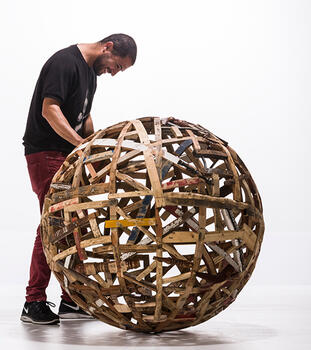Alejandro Tobón Rojas
Born in Medellin, Colombia in 1978 lives and works in Medellín.
He is a visual artist from Universidad Nacional de Colombia. He has been a professor at Fundación Universitaria Bellas Artes. He cofounded the Barrio Colombia Circuit in Medellín, Colombia in 2019. He also cofounded ‘Sal’ a space for culture in Medellín, Colombia in 2016 as well as the ‘Ojiva’ visual arts in Medellin, Colombia In 2013. He was codirector of the ‘Snack’ art festival Medellín, Colombia. He has participated in individual exhibitions featuring: (2019) ‘Fósiles en Movimiento’, La Cometa gallery, Bogotá, Colombia. (2017) ‘Nature’s Differences’ at cultural center Saint Marry Paris, France. (2013) ‘Fuera Abajo’, La Cometa gallery Bogotá, Colombia. (2010) ‘Fuerza Extraña’ at ‘Sala U’ gallery Universidad Nacional, Medellín, Colombia. Moreover, he has participated in collective exhibitions including: (2021) ‘Los 7 del Barrio Colombia + 2 invitados’, La Balsa art gallery Bogotá, Colombia. (2018) Scope, art fair Katapult gallery, Basel, Switzerland. (2017) ‘Patio de Esculturas’, MAMM (Modern Art Museum Medellín), Medellín, Colombia. (2014) Pinta, London’s art fair, London, England. (2013) ‘Sin Lugar Ni Cabeza’, Mark Hashem gallery, Paris, France. (2012) Preview, art fair, Berlín, Germany. (2005) “Arte Joven”, MAMBO (Modern Art Museum Bogotá), Bogotá, Colombia. Furthermore, he has received recognitions and awards.2019 winner of monumental work: ‘Medellín a Cielo Abierto’, Medellín, Colombia. (2019) Monumental work commission ‘El Cronista’, commercial and cultural center La Serrezuela, Cartagena, Colombia. (2017) international circulation scholarship, Medellin’s mayor’s office. (2012) residencyJA.CA institute for art and technology, Belo Horizonte, Brazil. (2016) Interactions,Ayacucho, accompanied by Connatural, Museum of Antioquia, Medellín, Colombia.
Statement
I have always been interested in what the search of an own place could mean. Hence, in my propositions I explore the value of earth, its distribution, and the ways I could safeguard it. In this sense, when I see what I recognize as territory, I question how earth, being a common natural resource, acquires the sense of a product that is negotiated in a systematic fragmented way. The possibilities inside the artistic practices allow me to use drawings, interdisciplinary dialogs, radiational manufacturing techniques, and technology and software to connect these ideas and configurate installed objects that I build with reusable materials like wood, iron, and polymers. I use geometric shapes as well as shapes from nature. I use these shapes with building principles typical of craftwork, architecture, and the industry. I use shapes and surfaces that interfere with places by occupying them and sometimes inviting the spectator to interact. This interaction generates effects and tours that give an account of the human presence on the territory.
